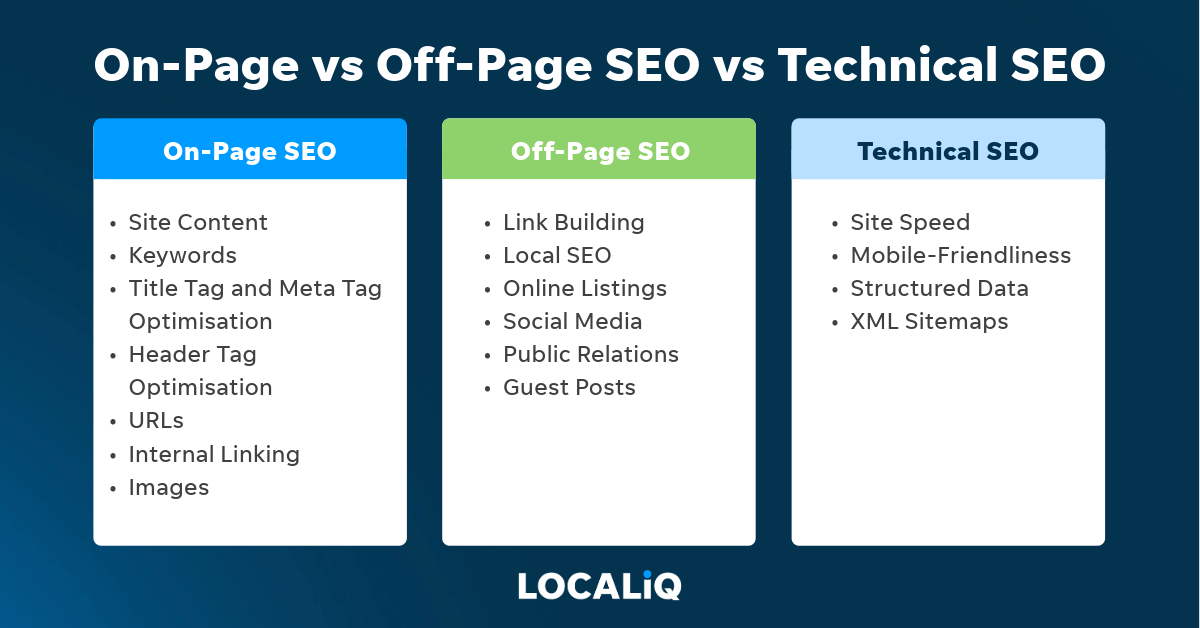On-page SEO (search engine optimisation) is a great place to start when trying to rank higher on Google. SEO should be a key focus for your business if you’re looking to generate long-term growth. In this blog we’ll explain all of the key components of a successful on-page SEO strategy.
This blog will cover:
- What is on-page SEO?
- Why is on-page SEO important?
- On-page and off-page SEO: What’s the difference?
- 12 on-page SEO strategies for your website
- Creating helpful content
- Optimising meta tags
- Utilising header tags
- Optimising URL structure
- Internal linking
- Optimising images
- Improving page load speed
- Improving mobile-friendliness
- Improving user experience (UX)
- Using structured data
- Integrating social sharing features
- Analysing on-page SEO performance
What is on-page SEO?
On-page SEO is the process of optimising individual web pages to rank higher on search engine results pages (SERPs). The goal is to ensure web pages are understandable and relevant to search engines and humans alike.
This involves various key elements such as content, page structure, meta descriptions and titles, and internal linking, all of which contribute to a page’s visibility and ranking potential. Unlike off-page SEO, which deals with external signals like backlinks, on-page SEO is entirely within your control. By focusing on on-page factors, businesses can create a strong foundation for their SEO efforts.
Prepare for SEO take off 🚀
Take the first step to ranking higher with our free SEO audit.
Get a complete overview of optimisation opportunities and uncover the actions you need to take to scale the SERPs.
Why is on-page SEO important?
SEO is important (particularly for businesses) as it gives your website more chance of being found online by potential customers searching for their products/services.
It’s important that businesses have a solid on-page SEO strategy to ensure they rank ahead of their competitors.
For instance, an online furniture store that created a stand alone “dining tables” web page 5 years ago is unlikely to rank above a website that regularly updates its page on dining tables and has also created additional pages for each category of dining tables it offers.
It’s important to note that on-page SEO is an ongoing process, it doesn’t have an end date unlike marketing strategies such as paid search, so in order to get the most out of your SEO strategy you should regularly review it and implement changes where needed
On-page vs off-page SEO: what’s the difference?
Whilst on-page SEO focuses on actions that can be carried out on your website, off-page is a series of actions that are conducted off-site to improve search ranking and generate traffic back to your website. Backlinks are considered to be the most important and valuable component of off-page SEO, but other tactics include social media and online listing optimisation.

12 On-page SEO strategies for your website
1. Create high-quality, helpful content
Content is at the heart of on-page SEO. Search engines like Google prioritise high-quality, relevant content that satisfies user intent. Businesses should focus on creating informative, engaging, and original content that addresses the needs and questions of their target audience.
Here’s how to ensure your content is SEO-friendly:
-
- Conduct keyword research: Identifying and incorporating relevant keywords is essential. Keyword research is the process of identifying terms and phrases that potential customers are likely to use when searching for products or services related to your business. Tools like Google Keyword Planner, Ahrefs, and SEMrush can help you identify high-traffic keywords with manageable competition levels.Keyword research is a vital part of on-page SEO, so don’t leave it down to guess work, make sure you invest time to conduct thorough research. If you’re not sure where to start, we’ve got a handy step-by-step guide to talk you through the basics.
-
- Ensure your content is relevant: Content should be highly relevant to the target audience. This means understanding their needs, preferences, and search behaviour. Creating buyer personas can help businesses tailor their content to meet specific audience segments.
-
- Structure your on-page content correctly: Well-structured content is easier for search engines to index and understand. This includes using headings (H1, H2, H3) to organise content, breaking text into short paragraphs, and incorporating bullet points where necessary to improve readability.
-
- Make sure your content is original: Search engines penalise duplicate content. Businesses should strive to produce original content that offers unique value. This not only helps in SEO but also establishes the business as a thought leader in its industry.
2. Optimise your meta tags
Meta tags, including the title tag and meta description, play a critical role in on-page SEO. These elements provide search engines and users with information about the content of a web page.
-
- Title tag: The title tag is one of the most important on-page SEO elements. It should be descriptive, include the primary keyword, and be within 50-60 characters to ensure it displays properly in search results. A compelling title tag can significantly impact click-through rates (CTR).
-
- Meta description: While not a direct ranking factor, the meta description influences CTR. It should provide a concise summary of the page content, include relevant keywords, and be around 150-160 characters. A well-crafted meta description can entice users to click on your link over others.
3. Correctly utilise header tags
Header tags (H1, H2, H3, etc.) are used to organise content and make it easier for users and search engines to understand.
The H1 tag should include the primary keyword and clearly indicate the main topic of the page. Subsequent header tags (H2, H3, etc.) should be used to structure the content into logical sections, each covering subtopics related to the main topic.
This hierarchical structure helps search engines understand the importance of different sections of your content and improves overall readability.
4. Enhance your URL structure
A clean, descriptive URL structure is beneficial for both SEO and user experience. URLs should be concise, include relevant keywords, and reflect the page’s content. Avoid using complex strings of numbers or unnecessary characters. For instance, a URL like “www.example.com/on-page-seo-tips” is preferable to “www.example.com/1234xyz”. Additionally, using hyphens to separate words in URLs makes them more readable than underscores or other characters.
5. Use internal linking
Internal linking is a powerful on-page SEO strategy that helps search engines understand the relationship between different pages on your website. By linking to other relevant pages within your site, you can help distribute page authority throughout your site, enhancing the SEO value of individual pages.
Internal linking can also help user experience by making it easier for visitors to find related content. By guiding users to related content, you increase the chance of keeping visitors engaged on your site longer, which positively impacts SEO.
When linking internally, ensure that the anchor text (the clickable text in a hyperlink) is descriptive and relevant to the page it links to. This helps both users and search engines understand what the linked page is about. Avoid using generic phrases like ‘click here’ or ‘read more’. Instead, use keyword-rich phrases that accurately describe the linked content, such as ‘learn more about our organic skincare range’ or ‘explore our collection of summer dresses’. This practice not only enhances user experience but also improves the SEO value of your links.
Regularly updating and maintaining your internal links is important as well. Over time, your website content will evolve, with new pages being added and old ones being removed or updated. Conduct periodic audits to ensure all internal links are functioning correctly and pointing to relevant, up-to-date content. Broken links can frustrate users and negatively impact your SEO, so it’s vital to address any issues promptly.
Ensure that internal links are relevant and add value to the user experience. Overloading a page with too many links can be counterproductive, so focus on quality over quantity.
6. Optimise images
Images are great for providing more context to your content, but they need to be optimised for SEO. This includes:
-
- Alt text: Providing descriptive alt text for images helps search engines understand what the image is about and improves accessibility for users with visual impairments. Including relevant keywords in the alt text can also boost SEO.
-
- File names: Use descriptive file names for images instead of generic ones like “IMG1234.jpg”. A file name like “on-page-seo-graph.jpg” is more informative and can improve image search rankings.
-
- Compression: Large image files can slow down page load times, negatively impacting SEO. Use tools like TinyPNG or ImageOptim to compress images without compromising quality. This ensures faster load times and a better user experience.
7. Improve page load speed
Page load speed is a critical factor in both user experience and SEO. Slow-loading pages can lead to higher bounce rates, as users are likely to abandon a site that takes too long to load. To improve page load speed:
-
- Optimise images: As mentioned earlier, be sure to compress your images to reduce file size. Additionally, use the appropriate file format (e.g., JPEG for photos, PNG for graphics with transparency)
-
- Minimise HTTP requests: Reduce the number of elements on your page (such as scripts, images, and CSS files) to lower the number of HTTP requests needed to load the page.
-
- Enable browser caching: Browser caching stores static files on users’ devices, allowing pages to load faster on subsequent visits.
-
- Optimise code: Minify CSS, JavaScript, and HTML code to reduce file sizes and remove unnecessary characters without affecting functionality.
8. Improve mobile-friendliness
With the increasing use of mobile devices, having a mobile-friendly website is essential for SEO. Google uses mobile-first indexing, meaning it primarily uses the mobile version of a site for indexing and ranking. To ensure your site is mobile-friendly you’ll want to implement a responsive design that adjusts the layout and content based on the device being used.
Ensure your web pages use the viewport meta tag to control layout on mobile browsers.
Consider using legible font sizes and ensure text is readable without requiring users to zoom, you’ll also need to make sure buttons and links are easily clickable with adequate spacing to avoid user frustration.
9. Focus on improving user experience (UX)
User experience is a significant factor in on-page SEO. Search engines aim to provide the best possible results to users, so a positive user experience can help improve your search rankings If Google can tell that your site is easy to use, and provides a high level of user satisfaction, it is more likely to feature your website higher up its results pages.
Key elements of good UX include:
-
- Easy navigation: A well-structured site with clear navigation helps users find the information they need quickly and easily.
-
- Engaging content: Use multimedia elements like videos, images, and infographics to make your content more engaging.
-
- Readability: Use clear fonts, sufficient white space, and an easy-to-read colour scheme to improve readability.
-
- Interactive elements: Features like comment sections, social media sharing buttons, and interactive tools can enhance user engagement.
10. Make use of structured data to gain rich snippets
Structured data, also known as schema markup, helps search engines understand the content of your pages better and can lead to rich snippets in search results. Rich snippets are enhanced search results that provide additional information, such as reviews, ratings, and event dates, which can improve CTR. To implement structured data:
-
- Identify relevant schema types: Determine which schema types are relevant to your content, such as articles, products, reviews, or events.
-
- Use Schema markup: Add the appropriate schema markup to your HTML. Tools like Google’s Structured Data Markup Helper can assist with this process.
-
- Test your markup: Use Google’s Rich Results Test to ensure your structured data is implemented correctly and can generate rich snippets.
11. Integrate social sharing features on your website
While social signals are not direct ranking factors, integrating social sharing features can indirectly benefit SEO. Social sharing can increase the visibility and reach of your content, driving more traffic to your site.
You can add social sharing buttons to your content to make it easier for users to share your content. Keep in mind that the content should be compelling and share-worthy in the first place. Implement Open Graph tags and Twitter Cards to ensure your content looks appealing when shared on social media platforms.
12. Monitor on-page SEO performance
SEO is not a one-time effort but an ongoing process. Regularly monitoring and analysing your website’s performance is crucial for continuous improvement. Key SEO metrics to track include:
-
- Organic traffic: Monitor the amount of traffic coming to your site from organic search.
-
- Average session duration: Measure how long visitors stay on your site, which can indicate engagement levels.
-
- Engagement rate: Track the percentage of engaged sessions on your website.
-
- Conversion rate: Track the percentage of visitors who complete desired actions, such as making a purchase or filling out a contact form.
-
- Keyword rankings: Monitor the rankings of your targeted keywords to assess the effectiveness of your SEO efforts.
Tools like Google Analytics, Google Search Console, and third-party SEO tools can provide valuable insights into your website’s performance. Use this data to identify areas for improvement and adjust your on-page SEO strategies accordingly.
Conclusion
On-page SEO is a vital component of a successful digital marketing strategy. By focusing on high-quality content, optimising meta tags and URLs, enhancing user experience, and continuously monitoring performance, businesses can improve their search engine rankings and drive more organic traffic. While the principles of on-page SEO are well-established, staying up-to-date with the latest trends and best practices is essential when it comes to search engine optimisation. By committing to ongoing optimisation and leveraging data-driven insights, businesses can achieve sustained online success and maintain a competitive edge in their industry.
Did you know that LOCALiQ has a team of award-winning SEO experts? If you’re looking for help getting started with SEO, get in touch with us today to see how we can help your business grow.






